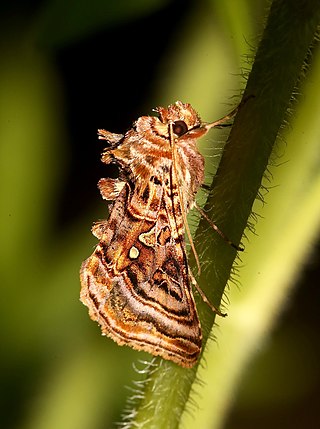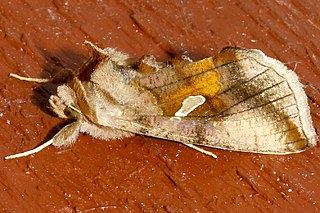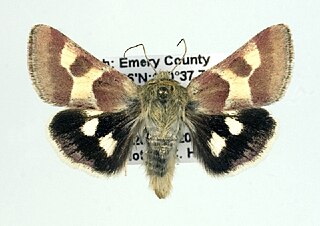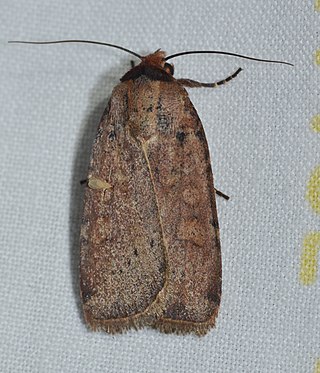
Copablepharon is a genus in the moth family Noctuidae. There are more than 20 described species in Copablepharon.

Feralia comstocki, or Comstock's sallow, is a moth of the family Noctuidae. The species was first described by Augustus Radcliffe Grote in 1874. It is found in North America from the southern Appalachians north to the Maritime provinces, west across the southern boreal forest to Vancouver Island, south to Oregon. In Alberta, the species has been collected from the Lake Athabasca and Zama areas south to about Pigeon Lake.

Acronicta sperata, the hopeful dagger moth, is a moth of the family Noctuidae. The species was first described by Augustus Radcliffe Grote in 1873. It is found in North America from New Brunswick west to the Alberta foothills, south to the District of Columbia, Missouri and in the mountains to Colorado.

Catocala meskei, or Meske's underwing, is a moth of the family Erebidae. The species was first described by Augustus Radcliffe Grote in 1873. It is found in North America from Maine and Quebec west to southern Alberta and Montana, south to South Carolina in the east and at least Montana in the west.

Andropolia aedon is a moth in the family Noctuidae first described by Augustus Radcliffe Grote in 1880. It is found in North America from British Columbia and Alberta south to California.

Globia oblonga, the oblong sedge borer, is a moth of the family Noctuidae. The species was first described by Augustus Radcliffe Grote in 1882. It is found in parts of Canada and the United States

Globia subflava, the subflava sedge borer or yellow sedge borer, is a moth of the family Noctuidae. The species was first described by Augustus Radcliffe Grote in 1882. It is found in North America from Nova Scotia west to British Columbia, south to New Jersey in the east and Utah and California in the west.

Autographa mappa, the wavy chestnut Y, is a moth of the family Noctuidae. The species was first described by Augustus Radcliffe Grote and Coleman Townsend Robinson in 1868. It is found in North America from Newfoundland west across the wooded portions of Canada to Vancouver Island, south in the east to Maine, New Hampshire and Wisconsin, and in the western mountains south to Colorado and Oregon.

Autographa metallica, the shaded gold spot, is a moth of the family Noctuidae. The species was first described by Augustus Radcliffe Grote in 1875. It is found in western North America from the southern Alaska coast and the Queen Charlotte and Vancouver Islands south to central California, east to the Alberta-British Columbia border and south in the Rocky Mountains to central Colorado.

Euxoa catenula is a species of moth of the family Noctuidae first described by Augustus Radcliffe Grote in 1879. It is found in North America from southern Saskatchewan west to southern Vancouver Island, south to Kansas, New Mexico, Arizona and southern California.

Schinia nuchalis, the spotted sage moth, is a moth of the family Noctuidae. The species was first described by Augustus Radcliffe Grote in 1878. It is found from the Great Plains and Great Basin, from southern Saskatchewan, Alberta and British Columbia south to northern Arizona. The Eurasian Schinia scutosa is no longer considered a synonym of Schinia nuchalis.

Schinia suetus is a moth of the family Noctuidae first described by Augustus Radcliffe Grote in 1873. It is widespread in the mountains of western North America, from southern Alberta west to British Columbia, south at least to Colorado and California, east to Idaho and New Mexico.

Schinia villosa, the little dark gem, is a moth of the family Noctuidae. The species was first described by Augustus Radcliffe Grote in 1864. In North America, it is mostly a western mountain species, however it has also been found across the plains eastward across Alberta and Saskatchewan to southern Manitoba. To the west it is found up to the coast ranges of Washington and British Columbia, south to Arizona.

Copablepharon grandis, the pale yellow dune moth, is a moth of the family Noctuidae. The species was first described by Strecker in 1878. It is found in North America from southern Alberta east to south-western Manitoba, the eastern parts of South Dakota, North Dakota and Iowa, west to California and south to southern Arizona, New Mexico and western Texas.

Copablepharon viridisparsa is a moth of the family Noctuidae first described by F. H. Wolley Dod in 1916. It is found from southern California and southern Utah north to southern British Columbia, central Saskatchewan and south-western Manitoba.

Protolampra brunneicollis, the brown-collared dart, is a moth of the family Noctuidae. The species was first described by Augustus Radcliffe Grote in 1864. It is found in eastern North America from New Brunswick to Alberta in southern Canada, and in the United States from Maine to North Carolina and Tennessee west to Mississippi, north to Minnesota, with scattered records in the west from North Dakota, South Dakota and Montana.
Xestia normaniana, or Norman's dart, is a moth of the family Noctuidae. The species was first described by Augustus Radcliffe Grote in 1874. It is found in North America from Nova Scotia across southern and central Canada to Alberta. In the eastern United States it ranges from Maine to eastern Minnesota, and south along the Appalachians to western North Carolina. It has recently been recorded from Tennessee.
Chrysanympha formosa, the Formosa looper, is a moth of the family Noctuidae. The species was first described by Augustus Radcliffe Grote in 1865. It is found in North America from Newfoundland west to Manitoba and south to the mountains of North Carolina and Tennessee.

Melitara dentata, the North American cactus moth, is a moth of the family Pyralidae. The species was first described by Augustus Radcliffe Grote in 1876. It is native to western North America, where it is widespread from Alberta to southern Arizona and central Texas. It is an introduced species in Hawaii.

Leuconycta lepidula, the marbled-green leuconycta moth, marbled-green jaspidia or dark leuconycta, is a moth of the family Noctuidae. The species was first described by Augustus Radcliffe Grote in 1874. It is found in North America from Nova Scotia to North Carolina, west to Texas and north to Alberta.














